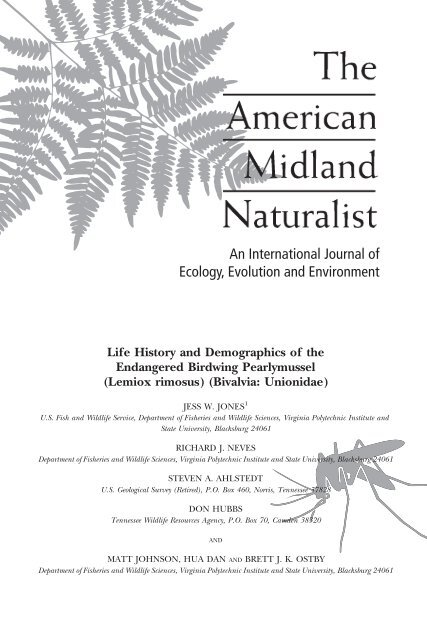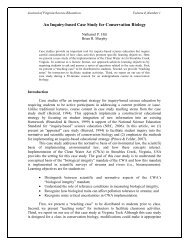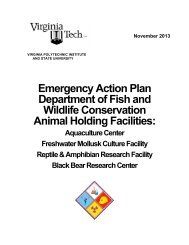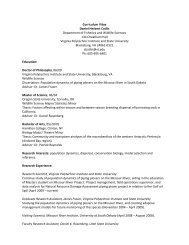An International Journal of Ecology, Evolution and Environment
An International Journal of Ecology, Evolution and Environment
An International Journal of Ecology, Evolution and Environment
You also want an ePaper? Increase the reach of your titles
YUMPU automatically turns print PDFs into web optimized ePapers that Google loves.
<strong>An</strong> <strong>International</strong> <strong>Journal</strong> <strong>of</strong><strong>Ecology</strong>, <strong>Evolution</strong> <strong>and</strong> <strong>Environment</strong>Life History <strong>and</strong> Demographics <strong>of</strong> theEndangered Birdwing Pearlymussel(Lemiox rimosus) (Bivalvia: Unionidae)JESS W. JONES 1U.S. Fish <strong>and</strong> Wildlife Service, Department <strong>of</strong> Fisheries <strong>and</strong> Wildlife Sciences, Virginia Polytechnic Institute <strong>and</strong>State University, Blacksburg 24061RICHARD J. NEVESDepartment <strong>of</strong> Fisheries <strong>and</strong> Wildlife Sciences, Virginia Polytechnic Institute <strong>and</strong> State University, Blacksburg 24061STEVEN A. AHLSTEDTU.S. Geological Survey (Retired), P.O. Box 460, Norris, Tennessee 37828DON HUBBSTennessee Wildlife Resources Agency, P.O. Box 70, Camden 38320ANDMATT JOHNSON, HUA DAN AND BRETT J. K. OSTBYDepartment <strong>of</strong> Fisheries <strong>and</strong> Wildlife Sciences, Virginia Polytechnic Institute <strong>and</strong> State University, Blacksburg 24061
Am. Midl. Nat. 163:335–350Life History <strong>and</strong> Demographics <strong>of</strong> theEndangered Birdwing Pearlymussel(Lemiox rimosus) (Bivalvia: Unionidae)JESS W. JONES 1U.S. Fish <strong>and</strong> Wildlife Service, Department <strong>of</strong> Fisheries <strong>and</strong> Wildlife Sciences, Virginia Polytechnic Institute <strong>and</strong>State University, Blacksburg 24061RICHARD J. NEVESDepartment <strong>of</strong> Fisheries <strong>and</strong> Wildlife Sciences, Virginia Polytechnic Institute <strong>and</strong> State University, Blacksburg 24061STEVEN A. AHLSTEDTU.S. Geological Survey (Retired), P.O. Box 460, Norris, Tennessee 37828DON HUBBSTennessee Wildlife Resources Agency, P.O. Box 70, Camden 38320ANDMATT JOHNSON, HUA DAN AND BRETT J. K. OSTBYDepartment <strong>of</strong> Fisheries <strong>and</strong> Wildlife Sciences, Virginia Polytechnic Institute <strong>and</strong> State University, Blacksburg 24061ABSTRACT.—The life history <strong>and</strong> population demography <strong>of</strong> the endangered birdwingpearlymussel (Lemiox rimosus) were studied in the Clinch <strong>and</strong> Duck rivers, Tennessee.Reproducing populations <strong>of</strong> L. rimosus now occur only in the Clinch, Duck <strong>and</strong> Powell rivers,as the species is considered extirpated from the remaining portions <strong>of</strong> its range in theTennessee River drainage. Females are long-term winter brooders, typically gravid from Oct.to May. Glochidia are contained in the outer gills <strong>and</strong> are released in association with amantle-lure that resembles a small freshwater snail. Estimated fecundity, based on 8 gravidfemales collected from the Clinch <strong>and</strong> Duck rivers, ranged from 4132 to 58,700 glochidia/mussel. Seven fish species were tested for suitability as hosts for glochidia, <strong>and</strong> five darterspecies were confirmed through induced infestations: Etheostoma blennioides, E. camurum, E.rufilineatum, E. simoterum <strong>and</strong> E. zonale. Ages <strong>of</strong> L. rimosus shells were determined by thinsectioning<strong>and</strong> ranged from 3 to 15 y in both rivers. Shell growth was higher <strong>and</strong> maximumsize greater in males than females in both rivers. Shell growth was greatest in the Duck River.Densities <strong>of</strong> L. rimosus in the Clinch River were maintained at seemingly stable but low levelsranging from 0.07 to 0.27 m 22 from 2004–2007, <strong>and</strong> in the Duck River at similar but higherlevels ranging from 0.6 to 1.0 m 22 from 2004–2006. In the latter river, abundance hasincreased since 1988, likely due to improved minimum flows <strong>and</strong> dissolved oxygen levels inwater releases from a reservoir upstream.INTRODUCTIONThe birdwing pearlymussel (Lemiox rimosus) typically inhabits gravel shoals <strong>of</strong> medium-tolargerivers <strong>of</strong> the Cumberl<strong>and</strong> Plateau <strong>and</strong> Southern Appalachian Mountains (Ortmann,1918). The species was first described by Rafinesque (1831) from the Cumberl<strong>and</strong> River;however, it was never again reported from this river system (Wilson <strong>and</strong> Clark, 1914; USFWS,1984). Hence, the locality information for the original collection record may be erroneous.1 Corresponding author: Telephone: (540) 231-2266; e-mail: Jess_Jones@fws.gov335
336 THE AMERICAN MIDLAND NATURALIST 163(2)FIG. 1.—Historic <strong>and</strong> current distribution <strong>of</strong> Lemiox rimosus in the Tennessee River drainageHistorically, this species was widespread throughout the Tennessee River drainage(Parmalee <strong>and</strong> Bogan, 1998) (Fig. 1). It once occurred in this drainage from its majorheadwater tributary streams (e.g., Powell, Clinch, Holston <strong>and</strong> French Broad rivers),downstream to Muscle Shoals in northern Alabama, <strong>and</strong> in the Duck River, Tennessee (TN)(Ortmann, 1918, 1924, 1925; USFWS, 1984). Although the species was once widespreadthroughout the drainage, it was never considered abundant at any location (Ortmann,1918). Reproducing populations <strong>of</strong> L. rimosus now are restricted to the Clinch <strong>and</strong> Powellrivers in Virginia (VA) <strong>and</strong> TN, <strong>and</strong> in the Duck River, which is considered to have thelargest population (USFWS, 1984; Parmalee <strong>and</strong> Bogan, 1998). Currently, the speciesoccupies ,10% <strong>of</strong> its historic range, occurring in only ,170 river kilometers (rkm) in theClinch River, ,84 rkm in the Powell River <strong>and</strong> ,60 rkm in the Duck River (USFWS, 1984).These remaining populations are disjunct, <strong>and</strong> range reductions <strong>and</strong> population declinesmay still be occurring even within the Clinch <strong>and</strong> Powell rivers (Ahlstedt <strong>and</strong> Jenkinson,1987; Ahlstedt, 1991; Ahlstedt <strong>and</strong> Tuberville, 1997; Ahlstedt et al., 2005). Dams, channeldredging, s<strong>and</strong> <strong>and</strong> gravel mining, coal mining, sewage wastes <strong>and</strong> agricultural run-<strong>of</strong>f havecaused or have likely contributed to declines in populations throughout its range. Because<strong>of</strong> severe population declines during the twentieth century, L. rimosus was listed asendangered by the U.S. Fish <strong>and</strong> Wildlife Service in 1976 (Federal Register 41:24062–24067). The objective <strong>of</strong> our study was to provide needed biological data specified in thefederal recovery plan for this species (USFWS, 1984), <strong>and</strong> to gather information on currentdistribution, life history <strong>and</strong> demography to aid in recovery.METHODSCollection <strong>and</strong> examination <strong>of</strong> gravid female mussels.—Gravid females <strong>of</strong> Lemiox rimosus wereobtained by snorkeling <strong>and</strong> examined for gravidity by opening the valves slowly by h<strong>and</strong> tolook for swollen gills containing glochidia. Female mussels were typically collected in fall<strong>and</strong> spring in the Clinch <strong>and</strong> Duck rivers. Female mussels were held in temperature-
2010 JONES ET AL.: BIRDWING PEARLYMUSSEL LIFE HISTORY AND DEMOGRAPHY 337controlled, water-recirculating artificial streams with gravel-filled bottoms at the FreshwaterMollusk Conservation Center at Virginia Polytechnic Institute <strong>and</strong> State University,Blacksburg, to study life history. Depending on when mussels were collected, watertemperatures in the artificial streams were set at 15 to 20 C to mimic ambient rivertemperatures.The number <strong>of</strong> glochidia (fecundity) from 2 females collected in the Clinch River <strong>and</strong> 6females collected in the Duck River was estimated by flushing glochidia from the outer gills<strong>of</strong> each female with a hypodermic needle filled with water. All glochidia were counted forsmaller females using a dissecting microscope to determine the number <strong>of</strong> glochidia/female to estimate fecundity. However, for the larger females, sub-samples <strong>of</strong> glochidia werecounted from 1 ml aliquots (n 5 3), <strong>and</strong> fecundity assessed volumetrically. Maturity <strong>of</strong> theglochidia was tested by exposing a small subset (,100) to a dilute salt solution (Zale <strong>and</strong>Neves, 1982). Glochidia were deemed mature when .20% exhibited rapid, sometimesmultiple, snapping responses when exposed to the NaCl solution. Dimensions (length 5anterior to posterior, height 5 dorsal to ventral) <strong>of</strong> 20 glochidia from each female musselwere measured using an ocular micrometer.Live female mussels were held in temperature-controlled (21–22 C) artificial streams forphoto-documentation. This laboratory set-up allowed females to display their mantle-lure<strong>and</strong> for behavioral observations <strong>of</strong> lure movements that were recorded under controlledconditions. All behavioral observations were made during daytime hours. Photographs <strong>of</strong>the mantle-lure were taken using a Nikonos V underwater camera with a 35 mm lens <strong>and</strong>Kodak 200 Ektachrome film.Fish hosts.—Based on preliminary studies conducted by Hill (1986) <strong>and</strong> Watson (1999), wefocused primarily on testing various darter species <strong>and</strong> one species <strong>of</strong> sculpin as potentialhosts. Most <strong>of</strong> the fish were collected from the upper North Fork Holston River, ,1 kmabove Saltville, Smyth County, VA. Black sculpins (Cottus baileyi) were collected from theMiddle Fork Holston River at Atkins, Smyth County, VA. Gilt darters (Percina evides) werecollected from the Powell River, Lee County, VA, at the State Route 833 bridge where Lemioxrimosus was rare. All other fish collection sites had few mussels <strong>and</strong> no birdwingpearlymussels. Fishes were collected using low voltage (200–250 V) electroshocking toensure survival. Common <strong>and</strong> scientific names follow Robins et al. (1991) for fishes <strong>and</strong>Turgeon et al. (1998) for mussels.Methods for infesting fish with mussel glochidia generally followed Zale <strong>and</strong> Neves(1982). A plastic container 29 3 19 3 12 cm deep was used to hold fish during infestation.Fish <strong>of</strong> various species were held simultaneously in ,0.5 L <strong>of</strong> water, <strong>and</strong> glochidia from 1–3females were added to the container. The water in the container was constantly agitated byusing 2 air stones positioned on opposite sides for ,1 h. After infestation, fish wereseparated by species <strong>and</strong> placed in 38-L aquaria without substrate. Fish species were heldseparately at low densities (6–8/aquaria) in a water-recirculating fish-holding system. Thebottoms <strong>of</strong> the aquaria were siphoned every 2 to 3 d until juvenile mussels were firstcollected, <strong>and</strong> every 1 to 2 d thereafter. Juveniles were counted <strong>and</strong> placed in a culture dishwith sediment <strong>and</strong> algae for rearing. Collection <strong>of</strong> mobile juveniles confirmed that theglochidia had transformed on the fish species, <strong>and</strong> that species was a potential natural host<strong>of</strong> Lemiox rimosus.Age <strong>and</strong> growth.—Fresh-dead shells <strong>of</strong> Lemiox rimosus were collected from various locationsin the Clinch <strong>and</strong> Duck rivers, TN between 1998 <strong>and</strong> 2007. Shells <strong>of</strong> various lengths werecollected to best represent the size-class structure <strong>of</strong> the population <strong>of</strong> each river. Thinsections<strong>of</strong> shells were prepared following procedures described by Clark (1980) <strong>and</strong> Neves
338 THE AMERICAN MIDLAND NATURALIST 163(2)<strong>and</strong> Moyer (1988), using a Buehler Isomet low-speed saw unit with a diamond-impregnatedblade (Buehler, Evanston, Illinois). Shells were cut from the center <strong>of</strong> the umbo to theventral margin. Cut valves were glued (2-Ton Clear Epoxy, Illinois Tool Works, Devcon,Massachusetts) to petrographic microslides (27 3 46 mm), vacuum-sealed into apetrographic chuck, attached to the cutting arm <strong>of</strong> the saw <strong>and</strong> sectioned at a thickness<strong>of</strong> 280 mm (Neves <strong>and</strong> Moyer, 1988). Thin-sections <strong>of</strong> shells were examined under 403magnification. Internal growth lines were considered true annuli if they were continuousfrom the umbo region to the outer surface <strong>of</strong> the shell. It was assumed, based on shell-agingin the rivers <strong>of</strong> southwest Virginia (Neves <strong>and</strong> Moyer, 1988), that one annulus was formedeach year. Lengths for 1 <strong>and</strong> 3 y old individuals, <strong>and</strong> occasionally older age classes, wereobtained by back-calculating length-at-age based on internal annuli <strong>of</strong> 5 older shells(Bruenderman <strong>and</strong> Neves, 1993) because shells ,3 y old <strong>and</strong> .10 y old were difficult tocollect from the river. Mean shell lengths <strong>and</strong> age for each sex were fitted to von Bertalanffygrowth curves.Population demography.—Several population demographic characteristics, such as density,abundance <strong>and</strong> age-class frequency, were estimated at sites in the Clinch <strong>and</strong> Duck rivers. Inaddition, a time series (1979–2004) <strong>of</strong> mussel density data was analyzed for the Clinch Riverat Kyles Ford, Hancock Co., TN (Ahlstedt et al., 2005), <strong>and</strong> Duck River at Lillard’s Mill,Marshall Co., TN (Ahlstedt, 1991; Ahlstedt et al., 2004). These two sites are considered thebest locations for the species in each river, respectively. The number <strong>of</strong> quadrat samplestaken at Kyles Ford was n 5 41 per sampling interval, <strong>and</strong> at Lillard’s Mill n 5 40 in 1979, n5 41 in 1988 <strong>and</strong> n 5 20 in 2004. These data were collected by r<strong>and</strong>om 0.25 m 2 quadratsampling in shoal areas that typically contained the highest mussel densities at the respectivesites to facilitate long-term monitoring. Additional data from 2004–2007 were collected fromboth rivers by systematic, 0.25 m 2 quadrat sampling placed along transect lines evenlyspaced throughout the entire shoal area [ J. Jones, USFWS, unpublished data; B. Ostby,Virginia Polytechnic Institute <strong>and</strong> State University (VPISU), unpublished data; Adair, 2005].Total area (m 2 ) <strong>of</strong> gravel shoals (mussel beds) was determined by multiplying mean riverwidth, measured at 10 m intervals, by total length <strong>of</strong> each reach. Small, exposed gravel bars<strong>and</strong> isl<strong>and</strong>s not containing mussels but within the immediate shoal area were measured <strong>and</strong>removed from analysis. Site dimensions (length <strong>and</strong> width) were measured using a st<strong>and</strong>ard100 m measuring tape. Upstream <strong>and</strong> downstream limits <strong>of</strong> the shoal were determined byvisually inspecting for substrate composition (e.g., an abrupt change from suitable gravelsubstrate to unsuitable bedrock or s<strong>of</strong>t sediments), water depth, flow velocity <strong>and</strong> absence <strong>of</strong>mussels. All 0.25 m 2 quadrats were excavated to hardpan, or to approximately 20 cm indepth. Mussels were measured for length (nearest 0.1 mm) using digital calipers <strong>and</strong>replaced at their approximate position <strong>of</strong> collection. Population size at each site wasestimated by multiplying mussel density (m 22 ) by total site area.Age-class frequency was determined by aging live mussels collected from 2004-2007 usingpredicted lengths-at-age as computed by a von Bertalanffy growth curve (VBGC) (vonBertalanffy, 1938). The VBGC is a modified logistic model written as:hiL t ~L ? 1{e {kt{t0 ð Þwhere L ‘ (L-infinity) is a theoretical maximum (asymptotic) length, k is a growthcoefficient, t is time or age in years, t 0 is the time in years when length would theoreticallybe equal to zero, <strong>and</strong> e is the natural log exponent. The species is sexually dimorphic, soall age <strong>and</strong> growth analyses were conducted separately for males <strong>and</strong> females in bothrivers.
340 THE AMERICAN MIDLAND NATURALIST 163(2)TABLE 1.—Reproductive condition <strong>of</strong> females <strong>of</strong> Lemiox rimosus collected from the Clinch Riverbetween 1997 <strong>and</strong> 2007Oct.–Nov. Dec.–Jan. Feb.–Mar. Apr.–May Jun.–Jul. Aug.–Sept.No. examined 9 1 3 25 6 1No. gravid (%) 4 (44) 0 (0) 3 (100) 4 (16) 0 (0) 0 (0)in late Aug. (B. Ostby, pers. obs., 2007). Fecundity <strong>of</strong> examined females ranged from 4132 to58,700 glochidia/female (Table 2).Fish hosts.—Five species <strong>of</strong> darters (Percidae) were identified as hosts from inducedinfestations <strong>of</strong> glochidia: greenside darter Etheostoma blennioides, bluebreast darter E.camurum, redline darter E. rufilineatum, snubnose darter E. simoterum <strong>and</strong> b<strong>and</strong>ed darter E.zonale (Table 3). Fish host usage <strong>and</strong> transformation success <strong>of</strong> glochidia were similarbetween the Clinch <strong>and</strong> Duck river populations. All <strong>of</strong> the identified fish hosts were native tothe Tennessee River system (Etnier <strong>and</strong> Starnes, 1993), <strong>and</strong> sympatric with Lemiox rimosus inall or part <strong>of</strong> its range. Peak transformation <strong>of</strong> glochidia to juveniles was protracted (.50 d)for infestations conducted in fall vs. spring (Table 3). For example in fall <strong>of</strong> 1997, E.blennioides <strong>and</strong> E. zonale were infested together, <strong>and</strong> excystment <strong>of</strong> juveniles peaked at 72 d<strong>and</strong> finished at 122 d (Fig. 3).Age <strong>and</strong> growth.—In the Clinch River, sample size <strong>of</strong> male shells was n 5 31 <strong>and</strong> totalsample size was n 5 66, which includes back-calculated length-at-age measurements(Table 4). Sample size <strong>of</strong> female shells was n 5 8 <strong>and</strong> total sample size n 5 44. In the DuckRiver, sample size <strong>of</strong> male shells was n 5 51 <strong>and</strong> total sample size was n 5 86; sample size <strong>of</strong>female shells was n 5 14 <strong>and</strong> total sample size was n 5 57.Based on aging <strong>of</strong> shells, the maximum age observed in either the Clinch or Duck riverpopulations was 15 y for males <strong>and</strong> 11 y for females. The smallest gravid individuals observedin either population ranged from 28 to 32 mm, implying that most females were mature at 4to 5 y. In the Clinch River, predicted shell growth for males averaged 3.8 mm/y through age0–10 y <strong>and</strong> decreased to 1.9 mm/y thereafter; females averaged 4.4 mm/y through age 0–6 y<strong>and</strong> decreased to 0.6 mm/y thereafter (Fig. 4; Table 4). In the Duck River, shell growth formales averaged 4.7 mm/y through age 0–10 y <strong>and</strong> decreased to 0.6 mm/y thereafter;females averaged 5.1 mm/y through age 0–6 y <strong>and</strong> decreased to 0.5 mm/y thereafter.Higher growth in the Duck River also is reflected in VBGC parameter estimates <strong>of</strong> thegrowth coefficient k, which were 0.244 y 21 (males) <strong>and</strong> 0.402 y 21 (females), compared to0.072 y 21 (males) <strong>and</strong> 0.309 y 21 (females) in the Clinch River (Fig. 4). Furthermore, a biasfor higher k in females is noted, <strong>and</strong> population comparisons are only valid within sexes.TABLE 2.—Shell lengths <strong>and</strong> fecundity estimates for gravid females <strong>of</strong> Lemiox rimosusDate examined River Shell length (mm) Glochidia/mussel3 Nov. 1997 Clinch 38.0 647911 No. 1998 Clinch 35.2 413225 Oct. 2001 Duck 32.7 10,74425 Oct. 2001 Duck 34.5 10,32025 Oct. 2001 Duck 27.3 70665 May 2007 Duck 39.5 21,8005 May 2007 Duck 42.3 13,5305 May 2007 Duck 43.0 58,700
2010 JONES ET AL.: BIRDWING PEARLYMUSSEL LIFE HISTORY AND DEMOGRAPHY 341TABLE 3.—Results <strong>of</strong> induced infestations on potential fish hosts with glochidia <strong>of</strong>Lemiox rimosus.Days-to-transformation was the first day <strong>and</strong> last day when juveniles excysted from a fish host. The peak(in parentheses) was when most juveniles excysted. Temperature is the mean water temperature in theaquaria where fish were held. * 5 successful host species; ND 5 no dataFish speciesNo. fishtestedNo.fish aliveTime(d)JuvenilesrecoveredDays totransformationTemperature(uC)CottidaeCottus baileyi c 15 14 93 0 ND 20.0Percidae*Etheostoma blennioides a 5 3 128 255 31, (72), 122 20.0*E. blennioides b 6 5 100 31 64, (72–74), 90 18.0*E. blennioides c 12 3 93 107 47, (57–70), 90 20.0*E. blennioides d 29 4 34 82 22, (25), 33 21.0*E. blenniodes f 26 15 66 18 12, (42), 46 21.0*E. blenniodes g 4 4 50 50 12, (36), 50 22.0*Etheostoma camurum f 7 4 66 1 17 21.0Etheostoma flabellare g 4 4 50 0 ND 22.0*Etheostoma rufilineatum f 20 12 66 20 12, (14–18), 19 21.0*E. rufilineatum g 18 12 50 1 50 22.0*Etheostoma simoterum a 18 2 100 19 47, (62–72), 82 20.0*E. simoterum c 20 17 50 70 31, (40–45), 48 20.0*E. simoterum d 20 8 34 227 22, (31–32), 34 21.0*Etheostoma zonale a 15 6 90 73 31, (67–72), 85 20.0E. zonale d 20 3 34 4 22–28 21.0Percina evides e 15 12 65 0 ND 21.0a Fish were infested together for 1 h with glochidia from 2 gills <strong>of</strong> 1 mussel from the Clinch River, TNon 3 Nov. 1997b Fish were infested together for 1 h with glochidia from 2 gills <strong>of</strong> 1 mussel from the Clinch River, TNon 11 Nov. 1998c Fish were infested together for 1 h with glochidia from 6 gills <strong>of</strong> 3 mussels from the Duck River, TNon 26 Oct. 2001d Fish were infested together for 1 h with glochidia from 4 gills <strong>of</strong> 2 mussels from the Clinch River, TNon 5 May 2002e Fish were infested together for 30 min with glochidia from 4 gills <strong>of</strong> 2 mussels from the Clinch River,TN on 28 May 2004f Fish were infested together for 40 min with glochidia from 6 gills <strong>of</strong> 3 mussels from the Duck River,TN on 4 May 2007g Fish were infested together for 60 min with glochidia from 2 gills <strong>of</strong> 1 mussel from the Clinch River,TN on 24 Jun. 2007Population demography.—In the Duck River, sample size <strong>of</strong> live individuals (n 5 117) wasgreater <strong>and</strong> better represents the actual age-class structure <strong>of</strong> the population (Fig. 5).Similarly, younger <strong>and</strong> middle-aged individuals predominate <strong>and</strong> constitute .80% <strong>of</strong> thesample, demonstrating high levels <strong>of</strong> recent recruitment in the population. In the DuckRiver, the VBGC equations predict that older individuals (10–15 y) are evident <strong>and</strong> mayinclude at least a few individuals .15 y, which can be seen in the age-frequency histogram.In contrast, total sample size <strong>of</strong> live individuals (n 5 21) collected during quantitativesampling in the Clinch River from 2004–2007 was small; therefore, inferences about ageclassstructure are speculative (Fig. 5). However, the sample was composed mostly <strong>of</strong> subadults(1–3 y) <strong>and</strong> middle-aged (4–8 y) adults, suggesting that older individuals (.10 y) are
342 THE AMERICAN MIDLAND NATURALIST 163(2)FIG. 3.—Protracted excystment <strong>of</strong> juveniles <strong>of</strong> Lemiox rimosus from greenside (n 5 5) <strong>and</strong> b<strong>and</strong>ed (n 515) darters. Glochidia were infested on these hosts in the fall <strong>of</strong> the year (Nov.) (see Table 3 for details)rare in the population (Fig. 5). Older individuals likely exist in the population, but theiroccurrence is seemingly uncommon <strong>and</strong> not detected in this limited sample. Thepredominance <strong>of</strong> younger individuals indicates that the population has been recruitingin the last 5 y. In the Clinch <strong>and</strong> Duck rivers respectively, sex ratio was 2:1 <strong>and</strong> 3:1 in favor <strong>of</strong>males.Densities <strong>of</strong> Lemiox rimosus in the Clinch River, TN, were at constant but low levels <strong>of</strong>#0.3 m 22 from 1979–2004 (Fig. 6). Based on data collected annually by systematic surveys atfour sites from 2004–2007, densities were at similar levels, <strong>and</strong> corresponding populationsizes ranged from 210 to 4003 individuals/site (Table 5). By comparison, densities in theDuck River, TN, were at higher levels, ranging from 0.57 to 6.0 m 22 from 1979–2004, with asignificant (P 5 0.011) increase observed from 1988 to 2004 (Fig. 6). However, based ondata collected by systematic surveys at three sites from 2004–2006, to include Lillard Mill,reported densities were lower <strong>and</strong> ranged from 0.6 to 1.0 m 22 ; corresponding populationsizes were from 2925 to 29,400 individuals/site (Table 5).DISCUSSIONMussel-host fish interactions <strong>and</strong> life history.—Previous host tests conducted by Hill (1986)<strong>and</strong> Watson (1999) found that several darter species served as suitable hosts for theglochidia <strong>of</strong> L. rimosus <strong>and</strong> that other families, including minnows (cyprinids), suckers(catostomids), <strong>and</strong> catfishes (ictalurids), were unsuitable hosts. Based on juveniletransformation success <strong>of</strong> previous studies <strong>and</strong> ours, the primary natural fish hosts arelikely Etheostoma blennioides, E. simoterum <strong>and</strong> E. zonale. These darters are morphologicallysimilar <strong>and</strong> phylogenetically related [all in the subgenus Ulocentra, Porter et al. (2002)], withthe former two species known to feed on snails ( Jenkins <strong>and</strong> Burkhead, 1994). However, aweakness <strong>of</strong> this study is that fish host tests were conducted using fish species from only the
2010 JONES ET AL.: BIRDWING PEARLYMUSSEL LIFE HISTORY AND DEMOGRAPHY 343upper Tennessee River drainage. Thus, additional trials using fish from the Duck River <strong>and</strong>other streams could reveal additional suitable hosts.The thick cartilaginous lips <strong>and</strong> jaw structure <strong>of</strong> Etheostoma blennioides may be adapted t<strong>of</strong>eeding on snails (Jenkins <strong>and</strong> Burkhead, 1994). During fish host trials, fish were fed adultsizedsnail species in the genera Leptoxis <strong>and</strong> Elimia, <strong>and</strong> their feeding behavior directlyobserved. A darter would quickly take a snail in its mouth, turn it to hold the operculumend, <strong>and</strong> then suck the s<strong>of</strong>t-body <strong>of</strong> the snail out <strong>of</strong> the shell, all in a matter <strong>of</strong> seconds. Inaddition, by supplementing its diet with snails while in captivity, its condition <strong>and</strong> survivalimproved, suggesting a preference <strong>and</strong> specialization for feeding on snails. Thus, host-usageby Lemiox rimosus seems to be relatively specific, as transformation success on other darterspecies i.e., E. rufilineatum <strong>and</strong> E. camurum which belong to the subgenus Nothonotus,generally was poor (Table 3). To our knowledge, L. rimosus is the only unionid that has amantle-lure display that mimics a freshwater snail.Since females <strong>of</strong> Lemiox rimosus were observed displaying in the fall, it is likely that someglochidia are released <strong>and</strong> attach to host fishes during this season. Our fish host resultsshowed that juvenile excystment was protracted for trials conducted in the fall. This delayedexcystment possibly indicates that glochidia were not completely mature. For example,immature glochidia have been observed in the fall in several other lampsiline musselspecies, including Cyprogenia stegaria, Dromus dromas <strong>and</strong> Epioblasma capsaeformis ( Jones <strong>and</strong>Neves, 2002; Jones et al., 2004, 2005). Why would a female display <strong>and</strong> release glochidia inthe fall that are not completely mature? Do the glochidia continue to mature while they areencysted <strong>and</strong> over-winter on their host? Over-wintering <strong>of</strong> glochidia on host fishes alreadyhas been documented in Lampsilis cardium <strong>and</strong> other species (see Watters <strong>and</strong> O’Dee, 1999<strong>and</strong> references therein), <strong>and</strong> presents an intriguing possibility for L. rimosus. Watters <strong>and</strong>O’Dee (1999) have shown that prolonged, cold water temperature (e.g., ,10 C) was likelythe controlling mechanism allowing for delayed excystment <strong>and</strong> over-wintering on host fish.We suggest that larval maturity may play a role as well, allowing glochidia to delaymetamorphosis, then excyst <strong>and</strong> settle during better growing conditions in the spring tomaximize 1st year growth.Age <strong>and</strong> growth.—Although maximum age recorded for Lemiox rimosus was 15 y, it ispossible that older animals may occur in both populations. However, locating olderindividuals in mussel populations is difficult due to their rarity. The predicted growthincrements <strong>and</strong> k-values in the Duck River population were higher than those in the ClinchRiver population. Biologists have long recognized the greater shell growth <strong>and</strong> productivity<strong>of</strong> mussels in the Duck River compared to other rivers in the Tennessee River system(Ortmann, 1924). The headwaters originate in the Highl<strong>and</strong> Rim <strong>of</strong> the Cumberl<strong>and</strong>Plateau <strong>and</strong> flow through various sedimentary layers <strong>of</strong> nutrient-rich siliceous limestone(Ortmann, 1924). Greater mussel growth <strong>and</strong> productivity likely are due to the moreeutrophic conditions generated by these rich sedimentary beds <strong>and</strong> the natural phosphatesthey contain. Other factors such as differences in seasonal water temperatures betweenrivers <strong>and</strong> population genetics also could play a role. However, the maximum observedlengths <strong>and</strong> ages converge for both populations at nearly identical values, perhapsindicating that genetically-based physiological differences are not the major factorcontrolling observed growth differences between populations.Aging live mussels by using the length-at-age growth curve method should be conductedwith caution. Predicted ages <strong>of</strong> larger <strong>and</strong> older individuals are less accurate as the slope <strong>of</strong>the curve decreases at its asymptote. As mussels reach older ages, annual growth incrementscan be miniscule (,1 mm), <strong>and</strong> shell growth becomes more variable, making predicted ages
344 THE AMERICAN MIDLAND NATURALIST 163(2)TABLE 4.—Observed <strong>and</strong> predicted shell lengths at internal annuli <strong>of</strong> Lemiox rimosus from the Clinch<strong>and</strong> Duck rivers. Number <strong>of</strong> individuals in parentheses is the sample size <strong>of</strong> back-calculated lengths-atagesInternalannulus (age) River SexNo. <strong>of</strong>individualsObserved length (mm)MeanRangePredictedlength (mm)Growthincrement(mm)0 Clinch Male 5 (5) 9.4 7.3–11.8 11.8 11.8Female 5 (5) 8.3 5.4–10.7 9.5 9.5Duck Male 5 (5) 8.2 6.0–10.4 8.8 8.8Female 5 (5) 7.7 6.5–10.1 8.2 8.21 Clinch Male 5 (5) 15.4 13.0–19.0 16.4 4.6Female 5 (5) 17.0 14.6–18.5 16.0 6.5Duck Male 5 (5) 18.3 15.7–20.1 19.1 10.3Female 5 (5) 18.2 14.0–23.1 18.1 9.92 Clinch Male 5 (5) 22.4 20.2–25.1 20.6 4.2Female 5 (5) 22.2 19.7–24.1 20.9 4.9Duck Male 5 (3) 29.2 23.5–36.3 27.1 8.0Female 6 (5) 25.9 21.7–28.7 24.7 6.63 Clinch Male 5 (5) 27.2 23.3–29.4 24.6 4.0Female 5 (4) 25.2 23.1–27.0 24.5 3.6Duck Male 5 (5) 33.7 30.2–35.8 33.5 6.4Female 6 (5) 30.3 27.2–32.5 29.2 4.54 Clinch Male 5 (2) 31.0 28.5–33.0 28.3 3.7Female 5 (4) 27.5 26.0–30.4 27.2 2.7Duck Male 5 (4) 39.9 36.0–43.9 38.4 4.9Female 6 (5) 31.7 29.8–34.4 32.2 3.05 Clinch Male 5 (2) 32.1 30.0–35.4 31.8 3.5Female 5 (3) 27.5 26.6–28.2 29.2 2.0Duck Male 5 (4) 41.9 38.2–45.2 42.3 3.9Female 5 (5) 32.8 31.0–35.4 34.1 1.96 Clinch Male 5 (5) 37.2 35.5–39.0 35.0 3.2Female 3 (2) 29.1 28.1–29.7 30.6 1.4Duck Male 5 (4) 43.7 38.4–47.6 45.3 3.0Female 5 (4) 34.1 31.6–36.9 35.5 1.47 Clinch Male 5 (1) 36.0 35.0–37.0 38.0 3.0Female 3 (2) 30.3 29.5–30.8 31.7 1.1Duck Male 7 (0) 45.6 43.5–48.6 47.7 2.4Female 5 (4) 35.5 34.3–37.1 36.4 0.98 Clinch Male 5 (0) 37.5 32.9–40.0 40.7 2.7Female 4 (2) 33.1 30.8–38 32.5 0.8Duck Male 6 (0) 49.6 44.9–53.8 49.5 1.8Female 6 (3) 36.5 35.3–38.4 37.0 0.69 Clinch Male 7 (0) 40.0 33–44 43.3 2.6Female 2 (1) 30.6 30.5–30.8 33.2 0.7Duck Male 8 (8) 52.8 45.6–59.4 51.0 1.5Female 4 (3) 37.3 36.2–39.1 37.4 0.410 Clinch Male 4 (0) 42.5 40.0–47.0 45.7 2.4Female 1 (1) 34.5 34.5 33.6 0.4Duck Male 7 (0) 50.7 46.9–55.3 52.1 1.1Female 3 (2) 39.4 36.5–43.8 37.6 0.211 Clinch Male 4 (2) 49.2 46.0–53.0 47.9 2.2Female 1 (0) 35.2 35.2 33.9 0.3
2010 JONES ET AL.: BIRDWING PEARLYMUSSEL LIFE HISTORY AND DEMOGRAPHY 345TABLE 4.—ContinuedInternalannulus (age) River SexNo. <strong>of</strong>individualsObserved length (mm)MeanRangePredictedlength (mm)Growthincrement(mm)Duck Male 7 (0) 50.9 42.5–59.3 53.0 0.9Female 1 (0) 38.7 38.7 37.8 0.212 Clinch Male 2 (2) 52.6 51.3–53.9 50.0 2.1Duck Male 5 (0) 57.3 53.2–58.7 53.7 0.713 Clinch Male 2 (1) 53.1 52.0–54.2 52.0 2.0Duck Male 4 (3) 52.6 48.1–57.2 54.3 0.614 Clinch Male 1 (1) 54.7 54.7 53.7 1.7Duck Male 5 (2) 53.8 48.7–57.2 54.7 0.415 Clinch Male 1 (0) 55.0 55.0 55.4 1.7Duck Male 2 (0) 57.4 57.2–57.5 55.1 0.4<strong>of</strong> older individuals less certain. Predicted ages <strong>of</strong> live mussels can be checked by countingexternal growth-rings to see whether the two methods are in agreement. External countstypically underestimate ages <strong>of</strong> older individuals <strong>and</strong> can be inaccurate if false annuli arecounted ( Jones <strong>and</strong> Neves, 2002). Aging mussels by external growth-rings also should beconducted carefully <strong>and</strong> be corroborated by length-at-age measurements obtained frominternal annuli to underst<strong>and</strong> population-specific growth patterns. In most studies, sacrifice<strong>of</strong> live mussels to estimate population age-class structure is unnecessary <strong>and</strong> would not bepermitted for an endangered species. Hence, both methods can be used together to providereasonably accurate age estimates <strong>of</strong> live individuals, especially for younger individuals(,5 y), <strong>and</strong> document important demographic processes <strong>and</strong> characteristics, such asrecruitment, maximum size <strong>and</strong> maximum age.FIG. 4.—Estimated von Bertalanffy growth curves for Lemiox rimosus populations showing predictedshell length-at-age. Observed mean length-at-age data are displayed as open circles, along with 95%confidence intervals (CI). Mean values without CI indicate samples sizes <strong>of</strong> #3. Total sample sizes (N) aregiven, which include back-calculated length-at-age data (see Results)
346 THE AMERICAN MIDLAND NATURALIST 163(2)FIG. 5.—Age-frequency histograms <strong>of</strong> Lemiox rimosus populations in the Clinch <strong>and</strong> Duck rivers; sexratio was 2:1 <strong>and</strong> 3:1 in favor <strong>of</strong> males, respectivelyPopulation trends <strong>and</strong> juvenile recruitment.—Most <strong>of</strong> the live specimens found in both riversbetween 2004 <strong>and</strong> 2007 were <strong>of</strong> small <strong>and</strong> medium sizes, indicating that these populationsare recruiting. Age histograms showed multiple age classes <strong>of</strong> young mussels (1–3 y),collectively comprising about 16% <strong>of</strong> sampled individuals in the Clinch River, <strong>and</strong> about12% in the Duck River (Fig. 4). Furthermore, the time-series <strong>of</strong> historical densities <strong>of</strong> Lemioxrimosus from 1979–2004 reported by Ahlstedt et al. (2004, 2005) indicated stable orincreasing population trends in each river, respectively (Fig. 6). Although these data werecollected using a different sampling design, the protocol was implemented consistently ateach time interval, thus providing additional insights into density trends over longer timeperiods. However, because the protocol sampled areas <strong>of</strong> best available habitat, density mayhave been over-estimated relative to total available habitat. Increasing abundance <strong>of</strong> L.
2010 JONES ET AL.: BIRDWING PEARLYMUSSEL LIFE HISTORY AND DEMOGRAPHY 347FIG. 6.—Historical densities <strong>of</strong> Lemiox rimosus from 1979–2004 in the Clinch River at Kyles Ford, TN<strong>and</strong> Duck River at Lillard Mill, TN; these are sites where the highest abundance <strong>and</strong> density <strong>of</strong> thespecies typically occurs in each river. Data are from Ahlstedt et al. (2004, 2005)rimosus <strong>and</strong> other mussel species in the Duck River during the past 15–20 y is attributedprimarily to reservoir release improvements (RRI) at the TVA’s Norm<strong>and</strong>y Dam (RiverKilometer 402) near Norm<strong>and</strong>y, TN (Ahlstedt et al., 2004). The RRI was initiated in 1991 toimprove minimum flows <strong>and</strong> dissolved oxygen levels in the river.Mortality is a dynamic process <strong>and</strong> can be difficult to assess. The unequal sex ratios <strong>and</strong>shorter longevity <strong>of</strong> females observed in this study suggest that female mortality is higher,perhaps due to reproductive stress <strong>and</strong> increased predation during mantle-lure display <strong>and</strong>the release <strong>of</strong> glochidia.
348 THE AMERICAN MIDLAND NATURALIST 163(2)TABLE 5.—Locality <strong>and</strong> population density data <strong>of</strong> Lemiox rimosus at selected sites in the Clinch <strong>and</strong>Duck rivers, TN. ND 5 individuals not detected in quadrat samples <strong>and</strong> NC 5 not calculatedQuadratsRiver Year (s) sampled Number Density Site PopulationSite locations kilometer sampled y 21 (n) collected m 22 (SD) area (m 22 ) size (95% CI)Clinch River:Wallen Bend(upper)309.6 2004 a 60 1 0.066 (0.516) 3183 210 (6415)2005 a 60 0 ND NC2006 a 60 1 0.066 (0.516) 210 (6415)2007 a 60 1 0.066 (0.516) 210 (6415)Kyles Ford 305.2 2004 b 146 7 0.190 (0.976) 15,000 2850 (62443)Frost Ford 291.7 2004 a 60 2 0.133 (0.724) 15,050 2002 (62756)2005 a 60 1 0.066 (0.516) 993 (61964)2006 a 60 4 0.266 (1.004) 4003 (63821)2007 a 60 0 ND NCSwan Isl<strong>and</strong> 277.2 2004 a 60 0 ND 5746 NC2005 a 60 0 ND NC2006 a 60 1 0.066 (0.516) 379 (6750)2007 a 60 0 ND NCDuck River:Lillard Mill 288.0 2006 c 254 90 1.42 (4.485) 22,500 22,500 (63931)Venable Spring 285.3 2004 d 285 46 0.650* 4500 2925Hooper Isl<strong>and</strong> 262.3 2006 c 169 27 0.639 (1.594) 49,000 29,400 (611,776)a Jones, J.W. 2004–2007. U.S. Fish <strong>and</strong> Wildlife Service, unpublished datab Ostby, B.J.K. 2005c Ostby, B.J.K., <strong>and</strong> R.J. Neves. 2007d Adair, B.D. 2005* St<strong>and</strong>ard deviation was not available, but likely similar to samples collected at Hooper Isl<strong>and</strong>Based on current population structure <strong>and</strong> trends, we believe that both the Clinch <strong>and</strong>Duck river populations <strong>of</strong> Lemiox rimosus are experiencing recruitment <strong>and</strong> are currentlystable. These populations should remain viable as long as habitat, water quality <strong>and</strong>ecological conditions are maintained in these rivers. The Clinch River population has beenat low densities (,0.5 m 22 ) for several decades, a trend that is likely to continue.Interestingly, Ortmann (1918) considered the species rare in the river in the early 1900s.Hence, the rarity <strong>of</strong> the species is seemingly natural, making monitoring a challenge.Finally, a remnant population <strong>of</strong> L. rimosus still resides in the Powell River in Tennessee <strong>and</strong>Virginia. Individuals occur at very low densities (,0.01 m 22 ) at sites <strong>of</strong> occurrence, butgravid females <strong>and</strong> young adults (#4 y) recently (2004–2007) have been observed in theriver. The viability <strong>of</strong> this population is unknown, but evidence <strong>of</strong> gravidity <strong>and</strong> recruitmentis encouraging.Conservation recommendations.—Recovery <strong>of</strong> Lemiox rimosus will require protection <strong>and</strong>expansion <strong>of</strong> existing populations, <strong>and</strong> establishment <strong>of</strong> additional populations intohistorically occupied habitat. A genetic analysis is needed to determine whether levels <strong>of</strong>divergence between the Clinch <strong>and</strong> Duck river populations warrant separate managementunits. However, utilizing the high abundance in the latter population as broodstockrepresents the best opportunity to recover the species throughout the Tennessee Riverbasin. Therefore, it is critical that water releases from Norm<strong>and</strong>y Dam be maintained at flow
2010 JONES ET AL.: BIRDWING PEARLYMUSSEL LIFE HISTORY AND DEMOGRAPHY 349<strong>and</strong> temperature levels that will continue to produce sustainable population recruitment <strong>of</strong>the species in the river.Acknowledgments.—This study was funded by Tennessee Wildlife Resources Agency, Nashville,Tennessee, Tennessee Valley Authority <strong>and</strong> U.S. Fish <strong>and</strong> Wildlife Service (USFWS), Asheville, NorthCarolina. The Virginia Cooperative Fish <strong>and</strong> Wildlife Research Unit is supported jointly by the U.S.Geological Survey, Virginia Department <strong>of</strong> Game <strong>and</strong> Inl<strong>and</strong> Fisheries, Wildlife Management Institute<strong>and</strong> Virginia Polytechnic Institute <strong>and</strong> State University. The authors would like to thank Dr. MichaelGangl<strong>of</strong>f (Appalachian State University) <strong>and</strong> Jeff Powell (USFWS) for providing shells <strong>of</strong> Lemiox rimosusfrom the Duck River, <strong>and</strong> Dr. Braven Beaty (The Nature Conservancy) <strong>and</strong> the anonymous referees fortheir comments <strong>and</strong> suggestions for improving the manuscript.LITERATURE CITEDADAIR, B. D. 2005. Patterns in the distribution <strong>of</strong> adult <strong>and</strong> juvenile freshwater mussels(Bivalvia:Unionidae) within a bed. M.S. Thesis, Tennessee Technological University, Cookeville.AHLSTEDT, S.A.AND J. J. JENKINSON. 1987. A mussel die-<strong>of</strong>f in the Powell River, Virginia <strong>and</strong> Tennessee, in1983, p. 21–28. In: R. J. Neves (ed.). Proceedings <strong>of</strong> the Workshop on Die-<strong>of</strong>fs <strong>of</strong> FreshwaterMussels in the United States. Virginia Polytechnic Institute <strong>and</strong> State University, Blacksburg.———. 1991. Cumberl<strong>and</strong>ian mollusk conservation program: mussel surveys in six Tennessee Valleystreams. Walkerana, 5:123–160.——— AND J. D. TUBERVILLE. 1997. Quantitative reassessment <strong>of</strong> the freshwater mussel fauna in theClinch <strong>and</strong> Powell rivers, Tennessee <strong>and</strong> Virginia, p. 72–97. In: K. S. Cummings, A. C.Buchanan, C. A. Mayer <strong>and</strong> T. J. Naimo (eds.). Conservation <strong>and</strong> management <strong>of</strong> freshwatermussels II. Upper Mississippi River Conservation Committee, Rock Isl<strong>and</strong>, Illinois.———, J. R. POWELL, R.S.BUTLER, M.T.FAGG, D.W.HUBBS, S.F.NOVAK, S.R.PALMER AND P. D. JOHNSON.2004. Historical <strong>and</strong> current examination <strong>of</strong> freshwater mussels (Bivalvia: Margaritiferidae,Unionidae) in the Duck River basin Tennessee. Final Report, Tennessee Wildlife ResourcesAgency, Nashville, Tennessee.———, M. T. FAGG, R.S.BUTLER AND J. E. CONNELL. 2005. Long-term trend information for freshwatermussel populations at twelve fixed-station monitoring sites in the Clinch <strong>and</strong> Powell Rivers <strong>of</strong>eastern Tennessee <strong>and</strong> southwestern Virginia. Final Report, U.S. Fish <strong>and</strong> Wildlife Service,Ecological Services, Cookeville, Tennessee.BRUENDERMAN, S.A. AND R. J. NEVES. 1993. Life history <strong>of</strong> the endangered fine-rayed pigtoe (Fusconaiacuneolus) (Bivalvia: Unionidae) in the Clinch River, Virginia. Am. Malacolog. Bull., 10:83–91.CLARK, G. R. 1980. Study <strong>of</strong> molluscan shell structure <strong>and</strong> growth lines using thin sections, p. 603–606.In: D. C. Rhoads <strong>and</strong> R. A. Lutz (eds.). Skeletal growth in aquatic organisms. Plenum Press,New York.ETNIER, D.A.AND W. C. STARNES. 1993. The fishes <strong>of</strong> Tennessee. University <strong>of</strong> Tennessee Press, Knoxville,Tennessee.HILL, D. M. 1986. Cumberl<strong>and</strong>ian Mollusk Conservation Program, Activity 3: Identification <strong>of</strong> fish hosts.Office <strong>of</strong> Natural Resources <strong>and</strong> Economic Development, Tennessee Valley Authority,Knoxville, Tennessee.HOGGARTH, M. A. 1999. Descriptions <strong>of</strong> some <strong>of</strong> the glochidia <strong>of</strong> the Unionidae (Mollusca: Bivalvia).Malacologia, 41:1–118.JENKINS, R.E. AND N. M. BURKHEAD. 1994. Freshwater fishes <strong>of</strong> Virginia. American Fisheries Society,Bethesda, Maryl<strong>and</strong>.JONES, J. W., R. A. MAIR AND R. J. NEVES. 2005. Factors affecting survival <strong>and</strong> growth <strong>of</strong> juvenile freshwatermussels (Bivalvia: Unionidae) cultured in recirculating aquaculture systems. N. Am. J. Aquacul.,67:210–220.———, R. J. NEVES, S.A.AHLSTEDT AND R. A. MAIR. 2004. Life history <strong>and</strong> propagation <strong>of</strong> the endangereddromedary pearlymussel, Dromus dromas (Bivalvia: Unionidae). J. N. Am. Benthol. Soc.,23:515–525.
350 THE AMERICAN MIDLAND NATURALIST 163(2)——— AND ———. 2002. Life history <strong>and</strong> propagation <strong>of</strong> the endangered fanshell pearlymussel,Cyprogenia stegaria Rafinesque (Bivalvia:Unionidae). J. N. Am. Benthol. Soc., 21:76–88.NEVES, R.J.AND S. N. MOYER. 1988. Evaluation <strong>of</strong> techniques for age determination <strong>of</strong> freshwater mussels(Unionidae). Am. Malacolog. Bull., 6:179–188.ORTMANN, A. E. 1918. The nayades (freshwater mussels) <strong>of</strong> the upper Tennessee drainage with notes onsynonymy <strong>and</strong> distribution. Proc. Am. Phil. Soc., 57:521–626.———. 1924. The naiad-fauna <strong>of</strong> the Duck River in Tennessee. Am. Mid. Nat., 9:18–62.———. 1925. The naiad fauna <strong>of</strong> the Tennessee River system below Walden Gorge. Am. Mid. Nat.,9:321–372.OSTBY, B. J. K. AND R. J. NEVES. 2007. <strong>An</strong> evaluation <strong>of</strong> substratum <strong>and</strong> flow preferences for rarefreshwater mussels in the Tennessee River drainage. Final Report, Tennessee Valley Authority,Knoxville, Tennessee.———. 2005. Characterization <strong>of</strong> suitable habitats for freshwater mussels in the Clinch River, Virginia<strong>and</strong> Tennessee. M.S. Thesis, Virginia Polytechnic Institute <strong>and</strong> State University, Blacksburg.PARMALEE, P.W.AND A. E. BOGAN. 1998. The freshwater mussels <strong>of</strong> Tennessee. University <strong>of</strong> TennesseePress, Knoxville, Tennessee.PORTER, B. A., T. M. CAVENDER AND P. A. FUERST. 2002. Molecular phylogeny <strong>of</strong> the snubnose darters,subgenus Ulocentra (Genus Etheostoma, Family Percidae). Mol. Phyl. <strong>and</strong> Evol., 22:364–374.RAFINESQUE, C. S. 1831. Continuation <strong>of</strong> a monograph <strong>of</strong> the bivalve shells <strong>of</strong> the river Ohio <strong>and</strong> otherrivers <strong>of</strong> the western states. By Pr<strong>of</strong>. C.S. Rafinesque. (Published at Brussels, Sept. 1920)Containing 46 species, from No. 76 to No. 121. Including an appendix on some bivalve shells <strong>of</strong>the rivers <strong>of</strong> Hindostan, with a supplement on the fossil bivalves <strong>of</strong> the Western states, <strong>and</strong> theTulosites, a new genus <strong>of</strong> fossils. Philadelphia, Pennsylvania. 8 p.ROBINS, C. R., R. M. BAILEY, C.E.BOND, J.R.BROOKER, E.A.LACHNER, R.N.LEA AND W. B. SCOTT. 1991.Common <strong>and</strong> scientific names <strong>of</strong> fishes from the United States <strong>and</strong> Canada. 5th ed. SpecialPublication 20. American Fisheries Society, Bethesda, Maryl<strong>and</strong>.TURGEON, D. D., J. F. QUINN, A.E.BOGAN, E.V.COAN, F.G.HOCHBERG, W.G.LYONS, P.M.MIKKELSEN, R.J.NEVES, C.F.E.ROPER, G.ROSENBERG, B.ROTH, A.SCHELTEMA, F.G.THOMPSON, M.VECCHIONE AND J.WILLIAMS. 1998. Common <strong>and</strong> scientific names <strong>of</strong> aquatic invertebrates from the United States<strong>and</strong> Canada: mollusks. 2nd ed. Special Publication 26. American Fisheries Society, Bethesda,Maryl<strong>and</strong>.USFWS (U.S. FISH AND WILDLIFE SERVICE). 1984. Birdwing pearly mussel recovery plan. U.S. Fish <strong>and</strong>Wildlife Service, Atlanta, Georgia. (Available from: Fish <strong>and</strong> Wildlife Reference Service, 5430Grosvenor Lane, Suite 110, Bethesda, Maryl<strong>and</strong> 20814 USA.)vON BERTALANFFY, L. 1938. A quantitative theory <strong>of</strong> organic growth. Hum. Biol., 10:181–213.WATSON, B. T. 1999. Population biology <strong>and</strong> fish hosts <strong>of</strong> several federally endangered freshwatermussels (Bivalvia: Unionidae) <strong>of</strong> the upper Tennessee River drainage, Virginia <strong>and</strong> Tennessee.M.S. Thesis, Virginia Polytechnic Institute <strong>and</strong> State University, Blacksburg.WATTERS,G.T.AND S. H. O’DEE. 1999. Glochidia <strong>of</strong> the freshwater mussel Lampsilis overwintering on fishhosts. J. Mollusc. Stud., 65:453–459.WILSON, C. B. AND H. W. CLARK. 1914. The mussels <strong>of</strong> the Cumberl<strong>and</strong> River <strong>and</strong> its tributaries.Document No. 781, US Bureau <strong>of</strong> Fisheries, Washington, DC. (This was also published in 1912)ZALE, A.V.AND R. J. NEVES. 1982. Fish hosts <strong>of</strong> four species <strong>of</strong> lampsiline mussels (Mollusca: Unionidae)in Big Moccasin Creek, Virginia. Can. J Zool., 60:2535–2542.SUBMITTED 9FEBRUARY 2009 ACCEPTED 24 JUNE 2009









